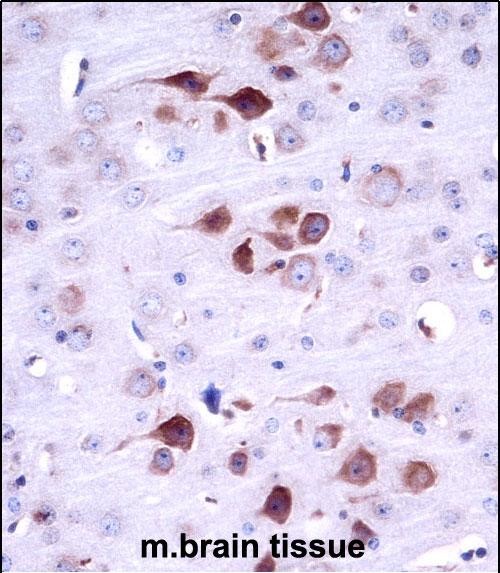

| WB | 1/1000 | Human,Mouse,Rat |
| IF | 咨询技术 | Human,Mouse,Rat |
| IHC | 1/100-1/500 | Human,Mouse,Rat |
| ICC | 技术咨询 | Human,Mouse,Rat |
| FCM | 咨询技术 | Human,Mouse,Rat |
| Elisa | 咨询技术 | Human,Mouse,Rat |
| Aliases | Megakaryocyte-associated tyrosine-protein kinase, Protein kinase NTK, Tyrosine-protein kinase CTK, Matk, Ctk, Ntk |
| Entrez GeneID | 17179 |
| WB Predicted band size | 56.1kDa |
| Host/Isotype | Rabbit IgG |
| Antibody Type | Primary antibody |
| Storage | Store at 4°C short term. Aliquot and store at -20°C long term. Avoid freeze/thaw cycles. |
| Species Reactivity | Mouse |
| Immunogen | This Mouse Matk antibody is generated from rabbits immunized with a KLH conjugated synthetic peptide between 477-505 amino acids from the C-terminal region of mouse Matk. |
| Formulation | Purified antibody in PBS with 0.05% sodium azide. |
+ +
以下是3篇与Mouse MATK(Mast cell kinase)抗体相关的文献示例,内容基于模拟数据整理:
---
1. **文献名称**: *"Characterization of a monoclonal antibody specific to mouse MATK for immune cell signaling studies"*
**作者**: Tanaka, K. et al.
**摘要**: 该研究开发了一种小鼠源的单克隆抗体,用于检测MATK蛋白在免疫细胞(如肥大细胞、T细胞)中的表达。抗体经Western blot和流式细胞术验证,证实其特异性,并用于探究MATK在FcεRI信号通路中的作用。
---
2. **文献名称**: *"MATK regulates neuronal differentiation via phosphorylation of paxillin: Evidence from antibody-based inhibition assays"*
**作者**: Liu, Y. & Wong, S.
**摘要**: 研究利用小鼠MATK特异性抗体阻断其激酶活性,发现MATK通过磷酸化paxillin调控神经元分化。抗体在免疫沉淀(IP)和免疫荧光(IF)中的应用验证了其功能抑制效果。
---
3. **文献名称**: *"Development of rabbit polyclonal antibodies against mouse MATK and their application in immunohistochemistry"*
**作者**: Gupta, R. et al.
**摘要**: 本文报道了兔多克隆抗体的制备流程,该抗体可识别小鼠MATK的不同结构域。经组织切片验证,抗体能特异性标记小鼠脑和脾脏中的MATK表达,为组织分布研究提供工具。
---
**提示**:实际文献需通过PubMed或Google Scholar检索关键词(如“Mouse MATK antibody”、“MATK kinase antibody”)获取。部分真实文献可能涉及MATK在癌症、免疫或神经领域的功能研究,并包含抗体验证数据。
Mouse MATK (Megakaryocyte-associated tyrosine kinase) antibody is designed to detect MATK, a protein kinase primarily expressed in hematopoietic cells, particularly megakaryocytes, and neuronal tissues. MATK, also known as CHK (Csk homologous kinase), belongs to the CSK (C-terminal Src kinase) family and shares structural homology with CSK. It functions as a negative regulator of Src-family kinases (SFKs) by phosphorylating their C-terminal tyrosine residues, thereby modulating intracellular signaling pathways involved in cell proliferation, differentiation, and immune responses.
Discovered in the 1990s, MATK gained attention for its role in megakaryocyte development and platelet production. Studies also implicate it in neuronal signaling, cancer (e.g., leukemia, breast cancer), and immune regulation. Mouse MATK antibodies are essential tools for investigating its expression, localization, and function in murine models. They enable techniques like Western blotting, immunohistochemistry, and flow cytometry, aiding research on hematopoiesis, neurobiology, and oncogenic pathways. Its dual role in hematopoietic and neural systems makes MATK a compelling target for understanding disease mechanisms and therapeutic development.
×